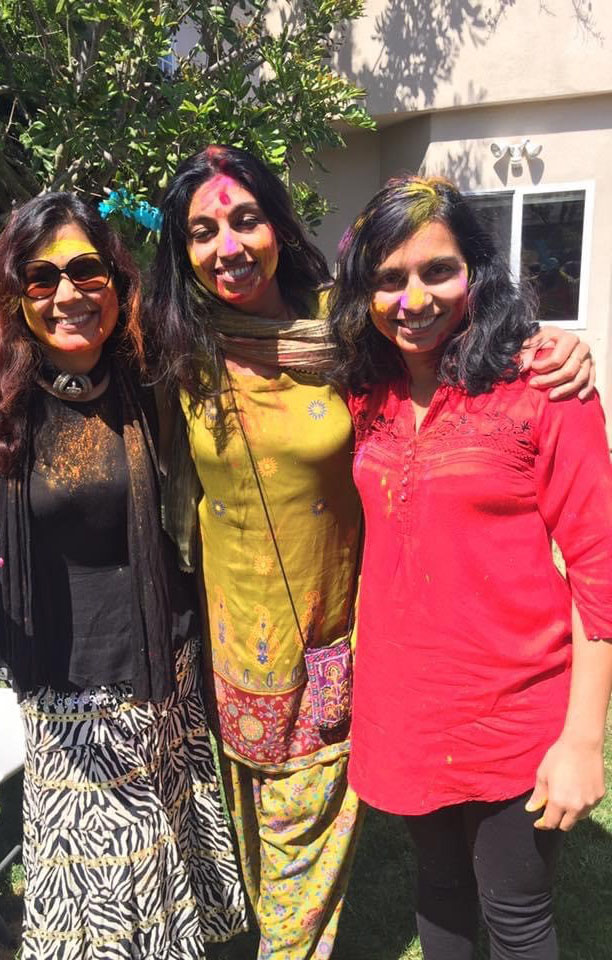Weaver Staff Celebrate Hindu Festival of Holi With Color and Joy

Weaver’s Inspire Impact Team: Courageous Conversations
“It’s a big colorful party to celebrate the arrival of spring and the triumph of good over evil.”
Splashes of color and paint on everyone and everything you see. Entire streets and towns filled with color, each with symbolic meaning. Imagine a tie-dye t shirt everywhere you look.
Welcome to Holi, a Hindu festival that a Weaver staff member calls “one massive celebration of positivity.” Known as the “festival of colors,” Holi celebrations of all sizes take place throughout the world during the full moon in spring, typically in March, and last for a night and a day.
On the first evening, Holika Dahan, people perform religious rituals in front of a fire to pray that their internal evil be destroyed. On the following day, Holi, families, friends, neighbors, and even strangers celebrate together by taking to the streets, smearing colors on one another, throwing water balloons and filling up water guns. Groups with drums and other musical instruments sing and dance from place to place. Each color carries a meaning. Red, for example, symbolizes love and fertility while green stands for new beginnings.
Holi’s origin dates back to the fourth century, and the story can be found in several works of ancient Indian literature. According to one popular version, an evil king became so powerful that he forced his subjects to worship him as their god. But to his ire, the king’s son, Prahlada, continued to be an ardent devotee of the Hindu deity Lord Vishnu. The angry king plotted with his sister, Holika, to kill his son.
Holika, who was immune to fire, tricked Prahlada into sitting in a pyre with her. When the pyre was lit, the boy’s devotion to Lord Vishnu helped him walk away unscathed while Holika, from whom the festival derives its name, was burned to death despite her immunity.
Here’s what Holi means to some of our Weaver employees:

“Holi is a celebration of many things, but very simply, it is a celebration of good over evil. It also represents the coming of spring, which brings a new season of possibilities. Holi combines a community, regardless of religious affiliation, into one massive celebration of positivity, represented by color.
“In my hometown of Corpus Christi, Indian families would organize a Saturday afternoon where we would gather at a local park and have an all-out color battle. When the time was right, we would chase each other and smear powdered colors over our friends and family. Our little brothers would fill their “Super Soakers” with water and spray us down. Our parents would play along too, tossing water balloons or dumping full buckets of colored water on us. Everyone knows to wear white shirts, so the color was clear; or showcased blank spots for MORE color to be slapped on. We would conclude by capturing pictures with our friends, each of us sopping wet and slathered with paint. It was so much fun!!” Neha Patel

“Holi is a popular Hindu festival of colors. It celebrates the arrival of spring. It is also celebrated as thanksgiving for good harvest. It is typically celebrated in March each year by putting color on the face and body of others in a friendly and fun loving atmosphere. It is the only time in the year where you can throw color and water balloons at people and mess up their pristine outfits and they won’t take offense.
“We typically celebrate Holi with friends. We get together with friends for a pot luck, put color on each other, sing, dance and have a feast. Water balloons are also thrown at each other. Kids and adults both enjoy Holi.
“As a kid, I used to look forward to Holi. We wore our oldest and most faded clothes that we did not mind throwing away or getting color on. We filled buckets with water balloons early in the morning and waited at our window to throw water balloons at unsuspecting passersby. All the neighborhood kids used to come out of their houses mid-morning to put color on each other and engage in water balloon fights. It took 1-2 days for the color to completely wash off our hair and nails but it was well worth it for the all-day fun we had on Holi. It was typically a holiday in India and so all adults and kids alike enjoyed playing Holi.” Sindhu Rajesh

“I have had the opportunity to celebrate Holi in both the U.S. and in India. In India, you can expect to be surprised with a bomb of powdered color by any one passing by. After celebrating Holi, I gathered with my family in India and enjoyed Indian sweets. In the U.S. this celebration takes place at a local park or temple where other Indian Americans celebrate the festive occasion with powdered color, music and Indian street food. Holi is one of my favorite Indian holidays. With the holiday falling in March, it coincides with the Texas spring and is a reminder that tennis weather is here to stay!” Mayur Naik

“I celebrated Holi in Hyderabad, India, a city of ten million people in southern India. It was a festive day filled with many colors and great people. Everyone brought colored powder and would throw it in the air and on each other. By the end of the day, I had been hit by many water balloons and covered in green, yellow, blue, and purple. The purple powder ended up staying on my face and hands throughout multiple showers, eventually disappearing after a few days.” Blake Fuqua
© 2021